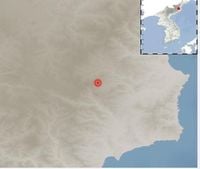On the morning of June 16, 2025, a minor earthquake rattled the region northwest of Kilju, a county in North Korea's North Hamgyong Province. The Korea Meteorological Administration (KMA) reported that the seismic event, registering a magnitude of 2.4, struck precisely at 7:04 a.m., shaking the area 43 kilometers north-northwest of Kilju.
According to official data, the earthquake's epicenter was pinpointed at 41.32 degrees North latitude and 129.16 degrees East longitude, with the tremor originating approximately 5 kilometers beneath the Earth's surface. The relatively shallow depth contributed to the detection of the quake, although its modest magnitude meant it was unlikely to cause significant damage or be widely felt.
The KMA quickly analyzed the event and confirmed that it was a natural earthquake rather than one induced by human activity. This distinction is particularly significant given the region's history and geopolitical context, where seismic events have sometimes been scrutinized for potential links to underground nuclear tests.
Kilju County has been in the global spotlight in the past due to its proximity to the Punggye-ri nuclear test site, North Korea's primary location for underground nuclear detonations. In recent years, seismic events in this area have drawn international attention, with experts and intelligence agencies closely monitoring any unusual tremors for indications of nuclear activity.
However, the Korea Meteorological Administration's assessment of this June quake underscores that it was a typical geological occurrence, caused by the movement of tectonic plates rather than man-made explosions. The KMA's statement, "analyzed as a natural earthquake," helps to alleviate immediate concerns about potential nuclear testing resuming at this site.
Natural earthquakes in this region are not uncommon, as the Korean Peninsula sits near the boundary of several tectonic plates. While North Korea is not known for frequent or large-scale earthquakes, minor tremors like this one are part of the area's geological activity. The 2.4 magnitude quake is considered minor and falls well below the threshold that would cause structural damage or widespread alarm.
Local and international observers often watch these seismic events closely, given the strategic importance of Kilju and the surrounding areas. The Punggye-ri site, located near Kilju, has been the center of North Korea's nuclear weapons development program, with several nuclear tests conducted there over the past two decades. Each test previously generated seismic signals that were distinguishable from natural earthquakes, often with higher magnitudes and unique signatures.
Seismologists and monitoring agencies worldwide use advanced techniques to differentiate between natural seismic activity and explosions caused by nuclear tests. The depth, magnitude, and wave patterns of the tremors provide vital clues. In this case, the shallow depth of 5 kilometers and the low magnitude align with typical natural earthquakes rather than underground detonations.
The timing of this earthquake comes amid heightened global attention on North Korea's nuclear ambitions and the international efforts to monitor and curtail its weapons program. While the region remains sensitive, the KMA's prompt and clear communication about the natural origin of this quake contributes to transparency and reduces speculation.
Residents near Kilju likely experienced only a faint shaking, if any sensation at all, given the quake's modest strength. The region’s infrastructure is not typically designed to withstand strong earthquakes, but the low magnitude means this event posed little to no threat to safety or property.
In summary, the June 16 earthquake northwest of Kilju was a minor, naturally occurring seismic event. The Korea Meteorological Administration's analysis confirms it was not linked to any nuclear testing or other human-induced activities. This clarification is crucial for maintaining regional stability and informing both domestic and international audiences about the nature of seismic activity in this geopolitically sensitive area.

